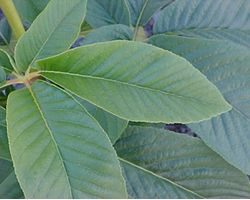- Aesculus californica
taxobox
name = "Aesculus californica"
regnum =Plantae
unranked_divisio =Angiosperms
unranked_classis =Eudicots
unranked_ordo =Rosids
ordo =Sapindales
familia =Sapindaceae
genus = "Aesculus "
species = "A. californica"
binomial = "Aesculus californica"
binomial_authority = (Spach) Nutt.|"Aesculus californica" (California Buckeye or California Horse-chestnut) is a species of buckeye endemic to
California , and the only buckeye native to the state.It is a large
shrub or smalltree growing to 4-12 m tall, with gray bark often coated withlichen s. The leaves are dark green, palmately compound with five (rarely seven) leaflets, each leaflet 6-17 cm long, with a finely toothed margin and (particularly in spring) downy surfaces. Theflower s are sweet-scented, white to pale pink, produced in erectpanicle s 15-20 cm long and 5-8 cm broad. Thefruit is a fig-shaped capsule 5-8 cm long, containing a large (2-5 cm), round, orangeseed ; the seeds are poisonous. The California Buckeye is a plant adapted to a dry climate; it starts dropping its leaves as soon as summer arrives to help it conserve water.It can be found along the central coast and the lower elevations of the Sierra Nevada, up to 1700 m altitude. It grows in oak woodlands and is dominant in some
chaparral habitats. The tree acts as a soil binder, which preventserosion in hilly regions. It is sometimes used as an ornamental.Local native tribes, including the Pomo,
Yokut , andLuiseño , used the poisonous nuts to stupefy schools of fish in small streams to make them easier to catch. The bark, leaves, and fruits contain the neurotoxicglycoside aesculin , which causeshemolysis ofred blood cell s. Indian groups occasionally used the nuts as a food supply, after boiling and leaching the toxin out of the nut meats for several days, although it was not a preferred food. Even the nectar of the flowers is toxic, and it can killhoneybee s and other insects which haven't coevolved with the tree. When the shoots are small and leaves are new they are low in toxins and are grazed by livestock and wildlife.ources
Casebeer, M. (2004). "Discover California Shrubs". Sonora, California: Hooker Press. ISBN 0-9665463-1-8
External links
* [http://ucjeps.berkeley.edu/cgi-bin/get_JM_treatment.pl?Aesculus+californica Jepson Flora Project: "Aesculus californica"]
* [http://www.coestatepark.com/aesculus_californica_garland.htm Photos of California Buckeye]
Wikimedia Foundation. 2010.
